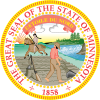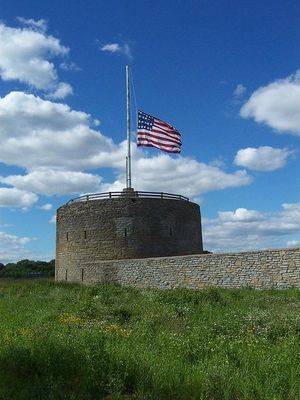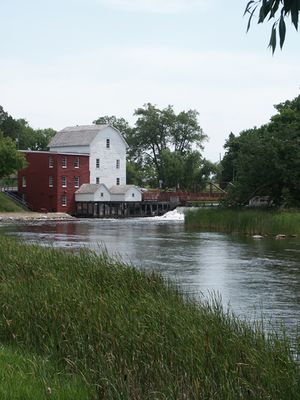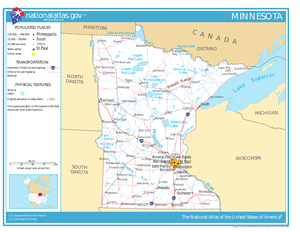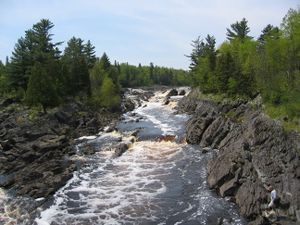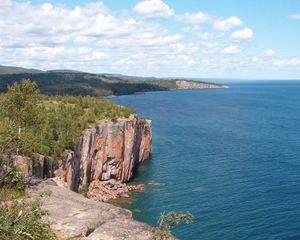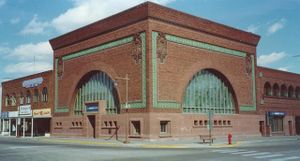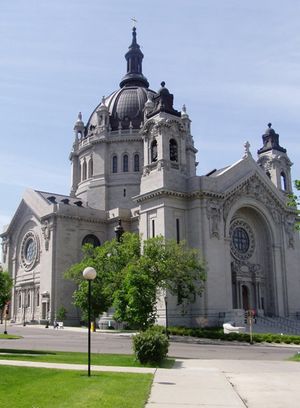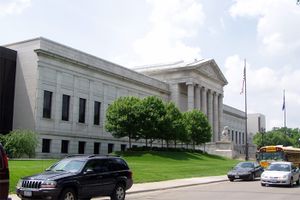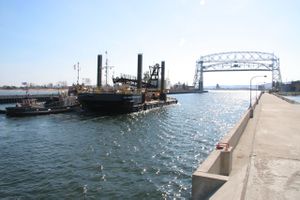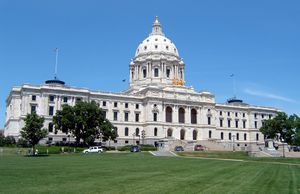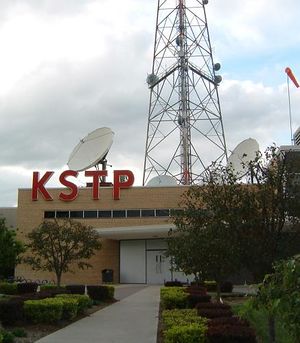مينيسوتا
| ||||||||||||||||||||||||||||||||||||||||||||||||||||||||||||||||||||||||||||||||||||||||||||||||||||||||
| ||||||||||||||||||||||||||||||||||||||||||||||||||||||||||||||||||||||||||||||||||||||||||||||||||||||||
مينيسوتا Minnesota وتعرف باسم الولاية ذات العشرة آلاف بحيرة. أهم مدنها هي مينياپوليس المتحدة معها مدينة سانت پول عاصمة الولاية ويطلق عليهما معا "المدينتان التوأم". كبرى ولايات الغرب الأوسط الأمريكي من حيث المساحة. وتعد من أهم مراكز إنتاج السلع الزراعية والمصنعة، كما يشكل المال والتجارة أهمية كبيرة لاقتصادها. تشكل مدينتا سانت پول ومينياپوليس الواقعتان في مينيسوتا منطقة حضرية رئيسية في الغرب الأوسط الأمريكي، وعاصمة الولاية سانت پول، أما أكبر المدن فهي منياپوليس. تقع في الوسط من الناحية الشمالية للولايات المتحدة يحدها من الشمال في كندا مقاطعتي مانيتوبا و أونتاريو ومن الغرب ولاية داكوتا الشمالية و داكوتا الجنوبية ومن الجنوب ولاية أيوا ومن الجنوب ولاية وسكنسن ، دخلت مينيسوتا الاتحاد عام 1858 وكانت الولاية رقم 32 التي تنضم للاتحاد.
في العصر الجليدي، تحركت الجبال الجليدية عبر مينيسوتا، وشكلت في طريقها السهول الممتدة في معظم أجزاء الولاية. وامتلأت آلاف الأحواض التي شكلتها الجبال الجليدية بالماء. حيث تضم الولاية أكثر من 15,000 بحيرة، تغطي مساحتها 4 هكتارات أو أكثر. تمتد منطقة سوبيريور المرتفعة عبر معظم النصف الشمالي من منيسوتا. وتضم أكثر أجزاء الولاية وعورة وعزلة، كما تحتوي على الكم الأكبر من مستودعات خام الحديد. وتغطي سهول يانج دريفت جزءًا كبيرًا من جنوبي مينيسوتا، وتضم أغنى الأراضي الزراعية في البلاد. كما تقع سهول دايسيكتيد تيل في الركن الجنوبي الغربي من الولاية، وتعد أجزاؤها المسطحة القليلة مثالية للزراعة. تغطي منطقة دريفتلز الركن الجنوبي الشرقي، ويكاد طرفها الجنوبي يكون منبسطًا. شقت الجداول وديانًا عميقة في الجزء الشرقي من المنطقة.
Minnesota, which gets its name from the Dakota language, has been inhabited by various Indigenous peoples since the Woodland period of the 11th century BCE. Between roughly 200 and 500 CE, two areas of the indigenous Hopewell tradition emerged: the Laurel complex in the north, and Trempealeau Hopewell in the Mississippi River Valley in the south. The Upper Mississippian culture, consisting of the Oneota people and other Siouan speakers, emerged around 1000 CE and lasted through the arrival of Europeans in the 17th century. French explorers and missionaries were the earliest Europeans to enter the region, encountering the Dakota, Ojibwe, and various Anishinaabe tribes. Much of what is now Minnesota formed part of the vast French holding of Louisiana, which the United States purchased in 1803. After several territorial reorganizations, the Minnesota Territory was admitted to the Union as the 32nd state in 1858. Minnesota's official motto, L'Étoile du Nord ("The Star of the North") is the only state motto in French; this phrase was adopted shortly after statehood and reflects both the state's early French explorers and its position as the northernmost state in the contiguous U.S.
As part of the American frontier, Minnesota attracted settlers and homesteaders from across the country. Its growth was initially based on timber, agriculture, and railroad construction. Into the early 20th century, European immigrants arrived in significant numbers, particularly from Scandinavia, Germany, and Central Europe; many were linked to the failed revolutions of 1848, which partly influenced the state's development as a center of labor and social activism.[7] Minnesota's rapid industrialization and urbanization precipitated major social, economic, and political changes in the late 19th and early 20th centuries; the state was at the forefront of labor rights, women's suffrage, and political reform.[8] Consequently, Minnesota is unique among Midwestern states in being a relative stronghold of the Democratic Party, having voted for every Democratic presidential nominee since 1976, longer than any other U.S. state.[9]
Since the late 20th century, Minnesota's economy has diversified away from traditional industries such as agriculture and resource extraction to services, finance, and health care; it is consequently one of the richest states in terms of GDP and per capita income. Minnesota is home to 11 federally recognized Native American reservations (seven Ojibwe, four Dakota), and its culture, demographics, and religious landscape reflect Scandinavian and German influence. In more recent decades, the state has become more multicultural, driven by both larger domestic migration and immigration from Latin America, Asia, the Horn of Africa, and the Middle East; the state has the nation's largest population of Somali Americans and second-largest Hmong community.[10] Minnesota's standard of living and level of education are among the highest in the U.S.,[11] and it is ranked among the best states in metrics such as employment, median income, safety, and governance.[12]
. . . . . . . . . . . . . . . . . . . . . . . . . . . . . . . . . . . . . . . . . . . . . . . . . . . . . . . . . . . . . . . . . . . . . . . . . . . . . . . . . . . . . . . . . . . . . . . . . . . . . . . . . . . . . . . . . . . . . . . . . . . . . . . . . . . . . . . . . . . . . . . . . . . . . . . . . . . . . . . . . . . . . . . .
أصل الاسم
اسم الولاية مشتق من اللغة لسكان أمريكا الأصليين وتعني (المياه الغائمة) وتسمى أيضا بولاية 10000 بحيرة ولكن عدد البحيرات قد يريد عن 15000 و4/3 البحيرات تزيد مساحته عن 10 هكتار, وتسمى الولاية أيضا بولاية السنجاب الأمريكي ويختلف في أصل هذه التسمية هل هي بسبب تواجد حيوان السنجاب في جنوب الولاية أو بسبب كاريكاتير من القرن 19 صور أصحاب اتحاد خط السكة الحديدية غير الصادقين على شكل سنجاب أمريكية. وتسمى أيضا بولاية نجم الشمال.
The word Minnesota comes from the Dakota[13] name for the Minnesota River, which got its name from one of two words in Dakota: "mní sóta", which means "clear blue water",[14][15] or "Mníssota", which means "cloudy water".[16][17] Dakota people demonstrated the name to early settlers by dropping milk into water and calling it mní sóta.[17] Many places in the state have similar Dakota names, such as Minnehaha Falls ("curling water" or waterfall), Minneiska ("white water"), Minneota ("much water"), Minnetonka ("big water"), Minnetrista ("crooked water"), and Minneapolis, a hybrid word combining Dakota mní ("water") and -polis (Greek for "city").[18]
التاريخ
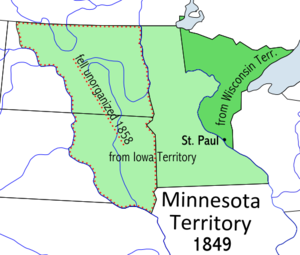
كان تجار الفراء الفرنسيون الذين وصلوا إلى إقليم مينيسوتا نحو عام 1660 أول البيض الذين وطئوا تلك البقاع، وكان هنود السو في ذلك الوقت يقطنون الغابات الشمالية بالإقليم، ثم استولى هنود الشيبوا على هذه الغابات، واحتدمت العداوات بين القبيلتين.
When Europeans arrived in North America, the Dakota people lived in what is now Minnesota. The first Europeans to enter the region were French voyageurs, fur traders who arrived in the 17th century. They used the Grand Portage to access trapping and trading areas further into Minnesota. The Anishinaabe (also known as Ojibwe or Chippewa) were migrating into Minnesota, causing tensions with the Dakota people,[19] and dislocated the Mdewakanton from their homelands along Mille Lacs Lake. Explorers such as Daniel Greysolon, Sieur du Lhut, Father Louis Hennepin, Jonathan Carver, Henry Schoolcraft, and Joseph Nicollet mapped the state.
The region was part of Spanish Louisiana from 1762 to 1802.[20][21] The portion of the state east of the Mississippi River became part of the United States at the end of the American Revolutionary War, when the Second Treaty of Paris was signed. Land west of the Mississippi was acquired with the Louisiana Purchase, though the Hudson's Bay Company disputed the Red River Valley until the Treaty of 1818, when the border on the 49th parallel was agreed upon.[22] In 1805 Zebulon Pike bargained with Native Americans to acquire land at the confluence of the Minnesota and Mississippi rivers to create a military reservation. The construction of Fort Snelling followed between 1819 and 1825.[23] Its soldiers built a grist mill and a sawmill at Saint Anthony Falls, which were harbingers of the water-powered industries around which Minneapolis later grew. Meanwhile, squatters, government officials, and others had settled near the fort; in 1839 the army forced them off military lands, and most moved downriver, just outside the military reservation, to the area that became St. Paul.[24]
وقعت أجزاء مختلفة من الإقليم في فترات مختلفة تحت السيطرة الفرنسية، والبريطانية والأسبانية والأمريكية. وبحلول القرن التاسع عشر، كانت الولايات المتحدة تمتلك الإقليم برُمَّته. وفي 1849 أسس مجلس الشيوخ الأمريكي إقليم مينيسوتا التي تحولت إلى ولاية بقرار من الكونجرس عام 1858. سار التطور الصناعي بخطى سريعة في الولاية بعد الحرب الأهلية الأمريكية (1861- 1865). وفي أواخر القرن التاسع عشر، استقر الآلاف من الألمان والنرويجيين والسويديين في الولاية.
وفي 1884 تم شحن أول دفعة من خام الحديد من مينيسوتا.
وفي 1889 تأسس مستشفى مايو في روتشستر، وهو واحد من أكبر مراكز البحوث الطبية في العالم.
بدأ الكثير من الصناعات الجديدة العمل في مينيسوتا في الخمسينيات من القرن العشرين، وبدأت صناعة الحديد تطور خام الصخر الصواني الذي يحتوي على الحديد. وأصبحت قضية تلوث الهواء والماء في المنطقة المحيطة بها تؤرق البلاد في السبعينيات والثمانينيات من القرن العشرين.
الجغرافيا
Minnesota is the second northernmost U.S. state (after Alaska) and northernmost contiguous state, as the isolated Northwest Angle in Lake of the Woods County is the only part of the 48 contiguous states north of the 49th parallel. The state is part of the U.S. region known as the Upper Midwest and part of North America's Great Lakes region. It shares a Lake Superior water border with Michigan and a land and water border with Wisconsin to the east. Iowa is to the south, North Dakota and South Dakota are to the west, and the Canadian provinces of Ontario and Manitoba are to the north. With 86,943 square miles (225,180 km2),[25] or approximately 2.25% of the United States,[26] Minnesota is the 12th-largest state.[27]
الجيولوجيا والتضاريس
Minnesota has some of the earth's oldest rocks, gneisses that are about 3.6 billion years old (80% as old as the planet).[28][29] About 2.7 billion years ago basaltic lava poured out of cracks in the floor of the primordial ocean; the remains of this volcanic rock formed the Canadian Shield in northeast Minnesota.[28][30] The roots of these volcanic mountains and the action of Precambrian seas formed the Iron Range of northern Minnesota. Since a period of volcanism 1.1 billion years ago, Minnesota's geological activity has been more subdued, with no volcanism or mountain formation, but with repeated incursions of the sea, which left behind multiple strata of sedimentary rock.[28]
In more recent times, massive ice sheets at least one kilometer thick ravaged the state's landscape and sculpted its terrain.[28] The Wisconsin glaciation left 12,000 years ago.[28] These glaciers covered all of Minnesota except the far southeast, an area characterized by steep hills and streams that cut into the bedrock. This area is known as the Driftless Zone for its absence of glacial drift.[31] Much of the remainder of the state has 50 feet (15 m) or more of glacial till left behind as the last glaciers retreated. Gigantic Lake Agassiz formed in the northwest 13,000 years ago. Its flatbed now is the fertile Red River valley, and its outflow, glacial River Warren, carved the valley of the Minnesota River and the Upper Mississippi downstream from Fort Snelling.[28] Minnesota is geologically quiet today; it experiences earthquakes infrequently, most of them minor.[32]
The state's high point is Eagle Mountain at 2,301 feet (701 m), which is only 13 miles (21 km) away from the low point of 601 feet (183 m) at the shore of Lake Superior.[30][33] Notwithstanding dramatic local differences in elevation, much of the state is a gently rolling peneplain.[28]
Two major drainage divides meet in Minnesota's northeast in rural Hibbing, forming a triple watershed. Precipitation can follow the Mississippi River south to the Gulf of Mexico, the Saint Lawrence Seaway east to the Atlantic Ocean, or the Hudson Bay watershed to the Arctic Ocean.[34]
The state's nickname "Land of 10,000 Lakes" is apt, as there are 11,842 Minnesota lakes over 10 acres (4 ha) in size.[35] Minnesota's portion of Lake Superior is the largest at 962,700 acres (389,600 ha; 3,896 km2) and deepest (at 1,290 ft (390 m)) body of water in the state.[35] Minnesota has 6,564 natural rivers and streams that cumulatively flow for 69,000 miles (111,000 km).[35] The Mississippi River begins its journey from its headwaters at Lake Itasca and crosses the Iowa border 680 miles (1,090 km) downstream.[35] It is joined by the Minnesota River at Fort Snelling, by the St. Croix River near Hastings, by the Chippewa River at Wabasha, and by many smaller streams. The Red River drains the northwest part of the state northward toward Canada's Hudson Bay. Approximately 10.6 million acres (4,300,000 ha; 43,000 km2) of wetlands are within Minnesota's borders, the most of any state outside Alaska.[36]
. . . . . . . . . . . . . . . . . . . . . . . . . . . . . . . . . . . . . . . . . . . . . . . . . . . . . . . . . . . . . . . . . . . . . . . . . . . . . . . . . . . . . . . . . . . . . . . . . . . . . . . . . . . . . . . . . . . . . . . . . . . . . . . . . . . . . . . . . . . . . . . . . . . . . . . . . . . . . . . . . . . . . . . .
النبيت والوحيش
Minnesota has four ecological provinces: prairie parkland, in the southwestern and western parts of the state; the eastern broadleaf forest (Big Woods) in the southeast, extending in a narrowing strip to the state's northwestern part, where it transitions into tallgrass aspen parkland; and the northern Laurentian mixed forest, a transitional forest between the northern boreal forest and the broadleaf forests to the south.[37] These northern forests are a vast wilderness of pine and spruce trees mixed with patchy stands of birch and poplar.
Much of Minnesota's northern forest has undergone logging, leaving only a few patches of old growth forest today in areas such as the Chippewa National Forest and the Superior National Forest, where the Boundary Waters Canoe Area Wilderness has some 400,000 acres (162,000 ha) of unlogged land.[38] Although logging continues, regrowth and replanting keep about a third of the state forested.[39] Nearly all Minnesota's prairies and oak savannas have been fragmented by farming, grazing, logging, and suburban development.[40]
While loss of habitat has affected native animals such as the pine marten, elk, woodland caribou, and bison,[41] others like whitetail deer and bobcat thrive. Minnesota has the nation's largest population of timber wolves outside Alaska,[42] and supports healthy populations of black bears, moose, and gophers. Located on the Mississippi Flyway, Minnesota hosts migratory waterfowl such as geese and ducks, and game birds such as grouse, pheasants, and turkeys. It is home to birds of prey, including the largest number of breeding pairs of bald eagles in the lower 48 states as of 2007,[43] red-tailed hawks, and snowy owls. Hawk Ridge is one of the premier birdwatching sites in North America. The lakes teem with sport fish such as walleye, bass, muskellunge, and northern pike, while brook, brown, and rainbow trout populate streams in the southeast and northeast.
المناخ
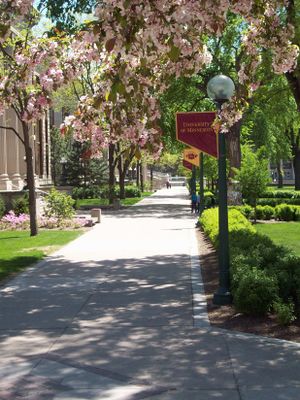
Minnesota experiences temperature extremes characteristic of its continental climate, with cold winters and hot summers. The lowest temperature recorded was −60 °F (−51 °C) at Tower on February 2, 1996, and the highest was 114 °F (46 °C) at Moorhead on July 6, 1936.[44] Meteorological events include rain, snow, blizzards, thunderstorms, hail, derechos, tornadoes, and high-velocity straight-line winds. The growing season varies from 90 days in the far northeast to 160 days in southeast Minnesota near the Mississippi River, and average temperatures range from 37 to 49 °F (3 to 9 °C).[45] Average summer dewpoints range from about 58 °F (14 °C) in the south to about 48 °F (9 °C) in the north.[45][46] Average annual precipitation ranges from 19 to 35 inches (48 to 89 cm), and droughts occur every 10 to 50 years.[45]
| الموقع | July (°F) | July (°C) | January (°F) | January (°C) |
|---|---|---|---|---|
| مينياپوليس | 83/64 | 28/18 | 23/7 | −4/−13 |
| سانت پول | 83/63 | 28/17 | 23/6 | −5/−14 |
| روتشستر | 82/63 | 28/17 | 23/3 | −5/−16 |
| Duluth | 76/55 | 24/13 | 19/1 | −7/−17 |
| St. Cloud | 81/58 | 27/14 | 18/−1 | −7/−18 |
| Mankato | 86/62 | 30/16 | 23/3 | −5/−16 |
| International Falls | 77/52 | 25/11 | 15/−6 | −9/−21 |
الأراضي المحمية
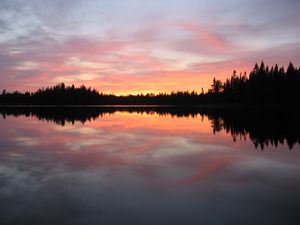
Minnesota's first state park, Itasca State Park, was established in 1891, and is the source of the Mississippi River.[48] Today Minnesota has 72 state parks and recreation areas, 58 state forests covering about four million acres (16,000 km2), and numerous state wildlife preserves, all managed by the Minnesota Department of Natural Resources. The Chippewa and Superior national forests comprise 5.5 million acres (22,000 km2). The Superior National Forest in the northeast contains the Boundary Waters Canoe Area Wilderness, which encompasses over a million acres (4,000 km2) and a thousand lakes. To its west is Voyageurs National Park. The Mississippi National River and Recreation Area (MNRRA) is a 72-mile-long (116 km) corridor along the Mississippi River through the Minneapolis–St. Paul Metropolitan Area connecting a variety of sites of historic, cultural, and geologic interest.[49]
المدن والبلدات
Saint Paul, in east-central Minnesota along the banks of the Mississippi River, has been Minnesota's capital city since 1849, first as capital of the Territory of Minnesota, and then as the state capital since 1858.
Saint Paul is adjacent to Minnesota's most populous city, Minneapolis; they and their suburbs are collectively known as the Twin Cities metropolitan area, the country's 16th-largest metropolitan area and home to about 55% of the state's population.[50] The remainder of the state is known as "Greater Minnesota" or "Outstate Minnesota".[51]
The state has 17 cities with populations above 50,000 as of the 2010 census. In descending order of population, they are Minneapolis, Saint Paul, Rochester, Duluth, Bloomington, Brooklyn Park, Plymouth, Saint Cloud, Woodbury, Eagan, Maple Grove, Coon Rapids, Eden Prairie, Minnetonka, Burnsville, Apple Valley, Blaine, and Lakeville.[52] Of these, only Rochester, Duluth, and Saint Cloud are outside the Twin Cities metropolitan area.
Minnesota's population continues to grow, primarily in the urban centers. The populations of metropolitan Sherburne and Scott counties doubled between 1980 and 2000, while 40 of the state's 87 counties lost residents over the same period.[53]
| Rank | المقاطعة | Pop. | |||||||
|---|---|---|---|---|---|---|---|---|---|
 مينياپوليس  سانت پول |
1 | مينياپوليس | Hennepin | 425,336 |  روتشستر  بلومنگتن | ||||
| 2 | سانت پول | رامسي | 307,193 | ||||||
| 3 | روتشستر | أولمستد | 121,465 | ||||||
| 4 | بلومنگتن | Hennepin | 89,298 | ||||||
| 5 | دولوث | سانت لويس | 86,372 | ||||||
| 6 | بروكلن پارك | Hennepin | 84,526 | ||||||
| 7 | پليموث | Hennepin | 79,828 | ||||||
| 8 | وودبري | واشنطن | 76,990 | ||||||
| 9 | Lakeville | داكوتا | 72,812 | ||||||
| 10 | بلين | أنوكا | 70,935 | ||||||
The United States Navy has recognized multiple Minnesota communities.
. . . . . . . . . . . . . . . . . . . . . . . . . . . . . . . . . . . . . . . . . . . . . . . . . . . . . . . . . . . . . . . . . . . . . . . . . . . . . . . . . . . . . . . . . . . . . . . . . . . . . . . . . . . . . . . . . . . . . . . . . . . . . . . . . . . . . . . . . . . . . . . . . . . . . . . . . . . . . . . . . . . . . . . .
التوزيع السكاني
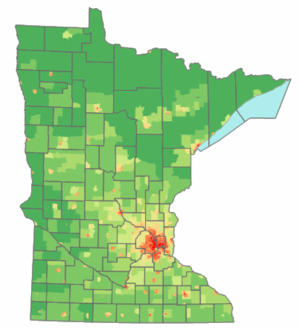
السكان
حسب إحصائيات عام 2004، يبلغ عدد سكان ولاية مينيسوتا ,100.9585، وبذلك تحتل الولاية المرتبة الواحد والعشرين من حيث تعداد السكان، وتبلغ نسبة الكثافة السكانية 64.1 شخص في الميل المربع، ويشكل البيض من أصول أوروبية غالبية عظمى تبلغ 90.2 %، والأمريكيون الأفارقة 3.9%، والآسيويون 3.3%، والأمريكيون اللاتينيون 3.3%، وآخرون من جزر هاواي 0.1%، و2% من أجناس أخرى. تبلغ نسبة المهاجرين في الولاية المولودين خارج الولايات المتحدة 5.3 %، والذين حصلوا على الجنسية 2%، وتبلغ نسبة من يملكون مساكنهم 76.4 %، بينما تبلغ نسبة الفقراء %18.9.
العرق والنسب
الدين
الإقتصاد
يتمتع التصنيع بالنصيب الأكبر من الإنتاج الاقتصادي في مينيسوتا. فيعد إنتاج أجهزة الحاسوب من الصناعات الرائدة، كما تعتبر صناعة معالجة اللحوم أهم الصناعات الغذائية. وتستخدم تجارتا الجملة والتجزئة نسبة أكبر من العمال عما في أي صناعة أخرى بالولاية. ويعتبر ميناء دولوث، أكبر الموانئ النهرية، وأبرز مراكز الشحن. يضم جنوب مينيسوتا بعضًا من أكثر الأراضي الزراعية إنتاجًا في الولايات المتحدة. ويحتل الحليب المركز الأول بين منتجات المزارع من حيث القيمة، ويأتي ترتيب الولاية في مكانة متقدمة بين الولايات المنتجة للذرة الشامية وفول الصويا والقمح. يأتي حوالي 70% من خام الحديد الذي يتم تعدينه في الولايات المتحدة من مينيسوتا، وتأتي أنواع الأخشاب القيِّمة من غابات شمال مينيسوتا الكثيفة. يبلغ إجمالي الناتج القومي لولاية مينيسوتا 225.6 بليون دولار وذلك طبقاً لإحصائيات عام 2004، ويبلغ متوسط دخل الفرد $ 35.861. ووصلت نسبة البطالة 4.7 % عام 2004، ويمثل قطاع الصناعة نسبة 14.3% من إجمالي الدخل العام للولاية، وقطاع الخدمات 22%، والقطاع الحكومي 15.5 %. تتميز الولاية بإنتاجها الضخم من المنتجات الزراعية، حيث تنتج الولاية الذرة والقمح وبنجر السكر، والبطاطس والفاصوليا الخضراء والشعير وفول الصويا، إلى جانب ذلك تنتج كميات كبيرة من الزبد، والبيض والألبان.
وتعتبر ولاية مينيسوتا من أكبر مناطق تصنيع أجهزة الكومبيوتر العملاقة خاصة في منطقة Twin Cities التي تضم كل من مدينة سانت بول ومدينة مينيابوليس، حيث تنتشر الكثير من مصانع الإلكترونيات والبلاستيك، وأجهزة المعامل ومصانع معالجة الأغذية، وتعد ولاية مينيسوتا رائدة صناعة المطبوعات والمنتجات الورقية حيث تشتهر العاصمة سانت بول Saint Paul بصناعة الأجندات الورقية، والكتب القانونية. وتحتوي ولاية مينيسوتا على أكبر نسبة من إنتاج الحديد الخام في الولايات المتحدة 75%، ويوجد في الولاية الكثير من الشركات مثل شركة كارجيل Cargill التي بلغ ربحها 71 بليون دولار عام 2005، وهي من كبرى شركات الأغذية في الولايات المتحدة، وهناك أيضا شركة 3M التي تنتج أكثر من 55000 منتج مثل المواد اللاصقة والمواد الكاشطة، كما توجد في مينيسوتا شركة ايميشن Imation لإنتاج أجهزة الكتابة على أسطوانات الكومبيوتر وكذلك تصنيع أقراص تسجيل البيانات CDs ويوجد في الولاية أيضا أكبر مركز تسوق في الولايات المتحدة وهو اسمه مول اوف أميركاMall of America، في منطقة التوأم ( Minneapolis and Saint Paul) في ضاحية بلومنيجنتن Bloomington.
الصناعة والتجارة

استخدام وانتاج الطاقة
ضرائب الدولة
الثقافة
الأدب
الترفيه
الصحة
التعليم
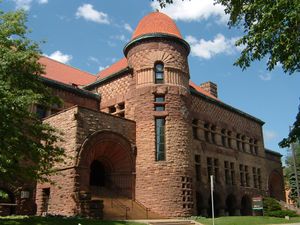
أهم الجامعات
- تعتبر جامعة University of Minnesota ,Twin Cities من أعرق الجامعات هناك وتأسست عام 1851 ولديها مبنيين، أحدهما في Minneapolis ، والأخر في Saint Paul ويبلغ عدد طلابها 51,157 . - جامعة Minnesota State University وهي جامعة حكومية تأسست عام 1868 ويبلغ عدد طلابها 14,000، وهي خاضعة لنظام ولاية مينيسوتا للكليات والمعاهد الفنية المدعومة ماليا من قبل الولاية ويتبع هذا النظام أكثر من 32 كلية ومعهد في مختلف مجالات التعليم. - جامعة University of Minnesota, Duluth ، وهي جامعة حكومية تأسست حكومية عام 1947، ويبلغ عدد طلابها 10,497 وهي تمنح درجة البكالوريوس في أكثر من 75 تخصص. - جامعة Metropolitan State University ، وتقع في منطقة Twin Cities وتأسست عام 1973 ويبلغ عدد طلابها 4,700.
النقل

القانون والحكومة
السلطة التنفيذية
السلطة التشريعية
السلطة القضائية
إقليمية
فيدرالية
السياسة
| Election results from statewide races[55] | ||||
|---|---|---|---|---|
| Year | Office | GOP | DFL | Others |
| 2008 | الرئيس | 43.8% | 54.1% | 2.1% |
| سناتور | 42.0% | 42.0% | 16.0% | |
| 2006 | الحاكم | 46.7% | 45.7% | 7.6% |
| Senator | 37.9% | 58.1% | 4.0% | |
| 2004 | President | 47.6% | 51.1% | 1.3% |
| 2002 | Governor | 44.4% | 33.5% | 22.1% |
| Senator | 49.5% | 47.3% | 1.0% | |
| 2000 | President | 45.5% | 47.9% | 6.6% |
| Senator | 43.3% | 48.8% | 7.9% | |
| 1998 | Governor | 34.3% | 28.1% | 37.6% |
| 1996 | President | 35.0% | 51.1% | 13.9% |
| Senator | 41.3% | 50.3% | 8.4% | |
| 1994 | Governor | 63.3% | 34.1% | 2.6% |
| Senator | 49.1% | 44.1% | 6.8% | |
| 1992 | President | 31.9% | 43.5% | 24.6% |
الإعلام
الرياضة والترفيه
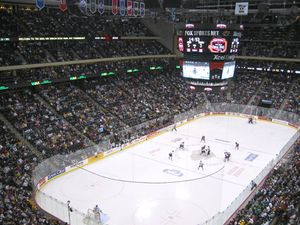
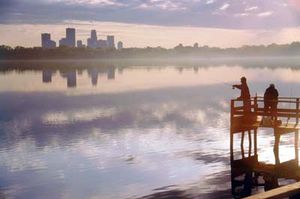
رموز الولاية
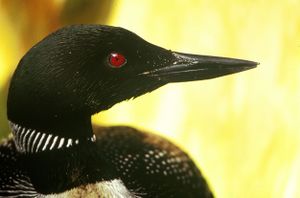
Minnesota's state symbols:[57]
- State bird: Common Loon
- State butterfly: Monarch
- State drink: Milk
- State fish: Walleye
- State flower: Pink and white lady slipper
- State fruit: Honeycrisp apple
- State gemstone: Lake Superior agate
- State grain: Wild rice
- State motto: L’Étoile du Nord ("The Star of the North")
- State muffin: Blueberry
- State mushroom: Morel
- State photograph: Grace
- State song: "Hail! Minnesota"
- State sport: Ice hockey
- State tree: Red Pine also known as Norway Pine
- Nicknames:
- "Land of 10,000 Lakes"
- "North Star State"
- "Gopher State"
- "Land of Sky-Blue Waters"
- "Bread and Butter State"
انظر أيضا
ملاحظات
- ^ أ ب Elevation adjusted to North American Vertical Datum of 1988.
المصادر
- ^ أ ب "Elevations and Distances in the United States". United States Geological Survey. 2001. Archived from the original on October 15, 2011. Retrieved October 24, 2011.
- ^ "Lake Superior Water Levels" Archived أغسطس 7, 2016 at the Wayback Machine, Great Lakes Environmental Research Laboratory. Updated daily.
- ^ "U.S. Census Bureau QuickFacts". QuickFacts. U.S. Census Bureau, 2021 Estimate. Archived from the original on February 13, 2022. Retrieved January 1, 2023.
- ^ "Median Annual Household Income". The Henry J. Kaiser Family Foundation. Archived from the original on December 20, 2016. Retrieved May 14, 2019.
- ^ "Minnesota State Demographic Center – Immigration & Language". Archived from the original on August 24, 2019. Retrieved November 30, 2019.
- ^ "Minnesota State Tree – Red Pine (Norway Pine)". State Symbols USA. October 11, 2014. Archived from the original on May 25, 2017. Retrieved May 21, 2017.
- ^ Jerabek, Esther. "The transition of a new world Bohemia" (PDF). Minnesota Historical Society. Archived (PDF) from the original on February 24, 2021. Retrieved May 10, 2020.
- ^ Backerud, Thomas K. (August 26, 2014). "What it meant to be 'progressive' in turn-of-the-century Minnesota". MinnPost (in الإنجليزية الأمريكية). Archived from the original on June 24, 2021. Retrieved June 22, 2021.
- ^ Ostermeier, Eric (September 3, 2015). "Republicans and Democrats Have Record Presidential Winning Streaks in 36 States". Smart Politics (in الإنجليزية الأمريكية). Archived from the original on November 11, 2020. Retrieved June 18, 2022.
- ^ Lee, Mai Na M. (October 5, 2021). "Hmong and Hmong Americans in Minnesota". MNopedia. Archived from the original on October 6, 2021. Retrieved October 6, 2021.
- ^ Frohlich, Thomas; Hess, Alexander E.M.; Kent, Alexander; Serenbetz, Robert (September 23, 2014). "America's Most (and Least) Educated States". 24/7 WallStreet. Archived from the original on February 3, 2015. Retrieved February 2, 2015.
- ^ Minnesota Rankings and Facts Archived يونيو 22, 2021 at the Wayback Machine | US News Best States
- ^ "Good Question: How Did Minnesota Get Its Name?". CBS Minnesota. May 11, 2015. Archived from the original on July 16, 2019. Retrieved September 9, 2019.
- ^ New Lakota dictionary. Lakota Language Consortium (2008).
- ^ "Mnisota". Dakota Dictionary Online. University of Minnesota Department of American Indian Studies. 2010. Archived from the original on October 2, 2013. Retrieved October 6, 2016.
- ^ "Mnisota". Dakota Dictionary Online. University of Minnesota Department of American Indian Studies. 2010. Archived from the original on May 25, 2017. Retrieved October 6, 2016.
- ^ أ ب "Minnesota State". Minnesota Historical Society. Archived from the original on سبتمبر 1, 2007. Retrieved أبريل 26, 2008.
- ^ "Minnehaha Creek". Minnesota Historical Society. Archived from the original on أبريل 30, 2011. Retrieved أبريل 26, 2008.
- ^ "TimePieces". Minnesota Historical Society. Archived from the original on سبتمبر 17, 2006. Retrieved سبتمبر 19, 2006.
- ^ "Louisiana Purchase – History, Facts, & Map". Encyclopedia Britannica. Archived from the original on May 1, 2015. Retrieved December 31, 2014.
- ^ Chamberlain, Charles; Faber, Lo. "Spanish Colonial Louisiana". Know Louisiana. Archived from the original on February 19, 2018. Retrieved February 18, 2018.
- ^ خطأ استشهاد: وسم
<ref>غير صحيح؛ لا نص تم توفيره للمراجع المسماةLass - ^ Gilman, Rhoda R. (July 1, 1991). The Story of Minnesota's Past. St. Paul, Minnesota: Minnesota Historical Society Press. ISBN 978-0-87351-267-1.
- ^ "Historic Fort Snelling". Minnesota Historical Society Press. Archived from the original on يوليو 16, 2012. Retrieved يوليو 6, 2006.
- ^ "Just the Facts". Minnesota North Star (official state government site). Archived from the original on April 1, 2009. Retrieved on July 4, 2009.
- ^ "Facts and figures". Infoplease. 2007. Archived from the original on June 15, 2013. Retrieved April 9, 2008.
- ^ "Land and Water Area of States, 2008". Information Please. 2011. Archived from the original on July 20, 2013. Retrieved October 13, 2014.
- ^ أ ب ت ث ج ح خ د ذ Ojakangas, Richard W. (1982). Minnesota's Geology. Illus. Dan Breedy. Minneapolis, Minnesota: University of Minnesota Press. ISBN 0-8166-0953-5.
{{cite book}}: Unknown parameter|coauthors=ignored (|author=suggested) (help) - ^ "Geologic Time: Age of the Earth". United States Geological Survey. October 9, 1997. Archived from the original on December 23, 2005. Retrieved April 9, 2008.
- ^ أ ب ت Breining, Greg (December 2005). Compass American Guides: Minnesota, 3rd Edition (3rd ed.). Compass American Guides. ISBN 978-1-4000-1484-2.
- ^ "Natural history – Minnesota's geology". Minnesota DNR. 2008. Archived from the original on October 10, 2006. Retrieved April 9, 2008.
- ^ "Table Showing Minnesota Earthquakes". University of Minnesota, Morris. Archived from the original on March 27, 2008. Retrieved April 9, 2008.
- ^ "118 km (73 mi) SW of Thunder Bay, Ontario, Canada". Topographic map. U.S.G.S via terraserver.microsoft.com. July 1, 1964. Archived from the original on October 9, 2013. Retrieved April 13, 2010.
- ^ "Continental Divides in North Dakota and North America". National Atlas. October 2, 2007. Archived from the original on May 13, 2008. Retrieved April 9, 2008.
- ^ أ ب ت ث "Lakes, rivers & wetlands". MN Facts. Minnesota DNR. 2008. Archived from the original on June 29, 2013. Retrieved April 9, 2008.
- ^ Seeley, Mark W. (2006). Minnesota Weather Almanac. Minnesota Historical Society press. ISBN 978-0-87351-554-2.
- ^ Ecological Provinces Archived أكتوبر 20, 2017 at the Wayback Machine, Ecological Classification System, Minnesota Department of Natural Resources (1999). Retrieved on May 3, 2008.
- ^ Heinselman, Miron (1996). The Boundary Waters Wilderness Ecosystem. Minneapolis, Minnesota: University of Minnesota Press. ISBN 978-0-8166-2805-6.
- ^ Bewer, Tim (2004). Moon Handbooks Minnesota (First ed.). Avalon Travel Publishing. ISBN 978-1-56691-482-6.
- ^ "Upper Midwest forest-savanna transition (NA0415)". Terrestrial Ecoregions. World Wildlife Fund. 2001. Archived from the original on April 29, 2001. Retrieved September 3, 2012. (archived from original June 11, 2008).
- ^ Bison disappeared in the mid-19th century; the last bison was reported in southwest Minnesota in 1879. Moyle, J. B. (1965). Big Game in Minnesota, Technical Bulletin, no. 9. Minnesota Department of Conservation, Division of Game and Fish, Section of Research and Planning. p. 172. As referenced in Anfinson, Scott F. (1997). Southwestern Minnesota Archaeology. St. Paul, Minnesota: Minnesota Historical Society. p. 20. ISBN 978-0-87351-355-5.
- ^ Gray Wolf Factsheet Archived أكتوبر 20, 2017 at the Wayback Machine, U.S. Fish and Wildlife Service (January 2007). Retrieved on May 3, 2008.
- ^ "Center for Biological Diversity". www.biologicaldiversity.org. Archived from the original on March 23, 2018. Retrieved December 15, 2011.
- ^ "Minnesota climate extremes". University of Minnesota. Archived from the original on October 5, 2006. Retrieved May 3, 2008.
- ^ أ ب ت "Climate of Minnesota" (PDF). National Weather Service Forecast Office. Archived from the original (PDF) on May 28, 2008. Retrieved May 3, 2008.
- ^ "104 Years of Twin Cities Dew Point Temperature Records: 1902–2006". Minnesota Climatology Office. March 7, 2006. Archived from the original on May 26, 2007. Retrieved April 6, 2008.
- ^ "Minnesota climate averages". Weatherbase. Archived from the original on October 9, 2015. Retrieved November 9, 2015.
- ^ "Itasca State Park". Minnesota Department of Natural Resources. Archived from the original on أبريل 3, 2008. Retrieved مايو 3, 2008.
- ^ "Places To Go". National Park Service, U.S. Department of the Interior. Archived from the original on April 13, 2013. Retrieved May 3, 2008.
- ^ Hibbs, James (November 1, 2016). "Analysis of the 2015 Population and Household Estimates" (Presentation). Demographic Reports and Analysis. Minnesota State Demographics Center. p. 2. Archived (PDF) from the original on June 28, 2018. Retrieved June 28, 2018.
Minnesota's estimated population in 2015 is 5,485,238. Over half (54.8%) of Minnesota's population lives in the seven Twin Cities area counties that make up Region 11. The population of Region 11 has surpassed three million.
- ^ "Greater Minnesota Refined and Revisited" (PDF). Minnesota State Demographics Center. State of Minnesota: Department of Administration. Archived (PDF) from the original on June 28, 2018. Retrieved June 28, 2018.
- ^ "Population Estimates". Minnesota Demographic Center. Archived from the original on March 7, 2008. Retrieved April 7, 2008.
- ^ "Environmental Information Report, App. D Socioeconomic Information" (PDF). Minnesota Pollution Control Agency. May 30, 2003. Archived from the original (PDF) on April 6, 2008. Retrieved April 7, 2008.
- ^ "QuickFacts". United States Census Bureau. Retrieved January 1, 2023.
- ^ http://uselectionatlas.org/RESULTS/
- ^ "All About Birds". Cornell Lab of Ornithology. 2003. Retrieved 2006-10-24.
- ^ "Minnesota State Symbols". Minnesota State Legislature. Retrieved 2008-04-28.
وصلات خارجية
عامة
- مينيسوتا at the Open Directory Project
الحكومة
- State of Minnesota Official site
- Minnesota State Legislature
- Minnesota Judicial Branch
- Hyperlinked state constitution
- Full text of state constitution
- Energy Data & Statistics for Minnesota- From the U.S. Department of Energy
السياحة والترفيه
الثقافة والتاريخ
- Minnesota Aviation Hall of Fame
- Minnesota Historical Society
- Minnesota history timeline
- Minnesota Historical Society's online timeline
- A History of Minneapolis: Early History: Resources
- Minnesota Place Names
- Forests, Fields, and the Falls: Connecting Minnesota
- Ramsey County Historical Society
الخرائط والجغرافيا
- Minnesota State Demographic Center
- Minnesota Health and Demographic Data
- USGS real-time, geographic, and other scientific resources of Minnesota
- Minnesota Demographics Facts
- Minnesota State Highway Map
- Perry-Castañeda Library Map Collection
- John R. Borchert Map Library
- Minnesota Geological Survey

|
بحيرة سوپيريور / مشيگن | أونتاريو، |
مانيتوبا، |

|
| وسكنسن | داكوتا الشمالية داكوتا الجنوبية | |||
| أيوا |
| سبقه كاليفورنيا |
قائمة الولايات الأمريكية حسب تاريخ الانضمام | تبعه أوريگون |
- CS1 الإنجليزية الأمريكية-language sources (en-us)
- CS1 errors: unsupported parameter
- Short description matches Wikidata
- Short description is different from Wikidata
- Articles containing فرنسية-language text
- Pages using infobox settlement with no coordinates
- Articles containing Dakota-language text
- Articles containing Greek-language text
- Articles with hatnote templates targeting a nonexistent page
- مقالات مميزة
- مينيسوتا
- ولايات الولايات المتحدة الأمريكية
- ولايات وأقاليم تأسست في 1858
- أسماء أماكن الداكوتا
- ولايات الغرب الأوسط
- تأسيسات 1858 في الولايات المتحدة
- الولايات المتحدة المتجاورة


